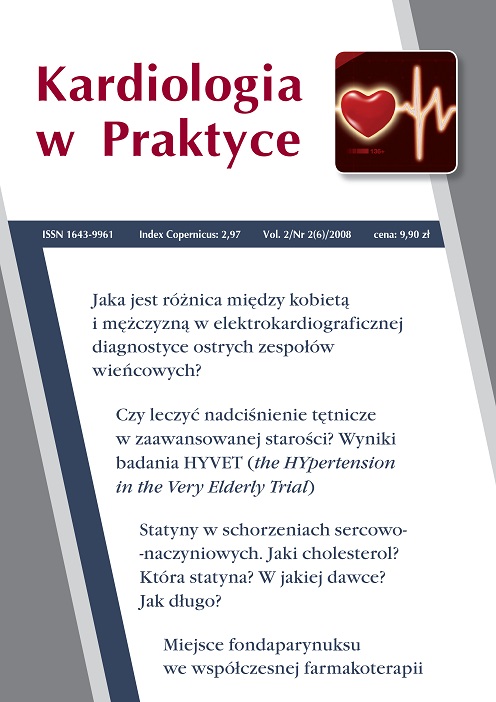Results of controlled, randomized clinical trials and hypotensive effects of drugs Review article
Main Article Content
Abstract
Controlled, randomized trials conducted up to now, revealed any significant differences in influence of hypotensive drugs on primary clinical endpoints. However results of some studies showed that drugs, irrespective of their blood pressure control, might exerted distinct clinical effects. One may speculate that it is a matter of poor blood pressure control or other factors play a role. Few finished last time studies may, at least in part, give some answers.
Downloads
Article Details

This work is licensed under a Creative Commons Attribution-NonCommercial-NoDerivatives 4.0 International License.
Copyright: © Medical Education sp. z o.o. This is an Open Access article distributed under the terms of the Attribution-NonCommercial 4.0 International (CC BY-NC 4.0). License (https://creativecommons.org/licenses/by-nc/4.0/), allowing third parties to copy and redistribute the material in any medium or format and to remix, transform, and build upon the material, provided the original work is properly cited and states its license.
Address reprint requests to: Medical Education, Marcin Kuźma (marcin.kuzma@mededu.pl)
References
2. Chobanian A.V., Bakris G.L., Black H.R. et al: The Seventh Report of the Joint National Committee on Prevention, Detection, Evaluation, and Treatment of High Blood Pressure: The JNC 7 Report. JAMA, 2003; 289: 2560-2571.
3. Prospective Studies Collaboration. Lancet 2002; 360: 1903-1913.
4. Julius S. (for the VALUE trial group): Outcomes in hypertensive patients at high cardiovascular risk treated with regimens based on valsartan or amlodipine: the VALUE randomised trial. Lancet 2004; 363: 2022-31.
5. Task Force Members: 2007 Guidelines for the Management of Arterial Hypertension. Journal of Hypertension 2007; 25:1105-1187.
6. Dahlöf B. (for the LIFE study group): Cardiovascular morbidity and mortality in the Losartan Intervention For Endpoint reduction in hypertension study (LIFE): a randomized trial against atenolol. Lancet 2002; 359: 995-1003.
7. Schrader J. (for the MOSES Study Group): Morbidity and Mortality After Stroke, Eprosartan Compared With Nitrendipine for Secondary Prevention Principal Results of a Prospective Randomized Controlled Study (MOSES). Stroke 2005; 36: 1218-1226.
8. Dahlöf B., Sever P.S., Poulter N.R. (for the ASCOT investigators): Prevention of cardiovascular events with an antihypertensive regimen of amlodipine adding perindopril as required versus atenolol adding bendroflumethiazide as required, in the Anglo-Scandinavian Cardiac Outcomes Trial-Blood Pressure Lowering Arm (ASCOT-BPLA): a multicentre randomized controlled trial. Lancet 2005; 366: 895–906.
9. The CAFE Investigators for the Anglo-Scandinavian Cardiac Outcomes (ASCOT) Investigators: Differential impact of blood pressure–lowering drugs on central aortic pressure and clinical outcomes: principal results of the Conduit Artery Function Evaluation (CAFE) study. Circulation 2006; 113: 1213-1225.
10. Dart A.M., Cameron J.D., Gatzka C.D. et al.: Similar Effects of Treatment on Central and Brachial Blood Pressures in Older Hypertensive Subjects in the Second Australian National Blood Pressure Trial. Hypertension 2007; 49: 1242-1247.
11. The HOPE study investigators: Effects of an angiotensin- converting–enzyme inhibitor, ramipril, on cardiovascular events in high-risk patients. N. Engl. J. Med. 2000; 342: 145-153.
12. Svensson P., Faire U., Sleight P., Yusuf S., Östergren J.: Comparative effects of ramipril on ambulatory and office blood pressures: A HOPE substudy. Hypertension2001; 38: e28–e32.
13. The DREAM Trial Investigators: Effect of Ramipril on the Incidence of Diabetes. N. Engl. J. Med. 2006; 355: 1551-62.

